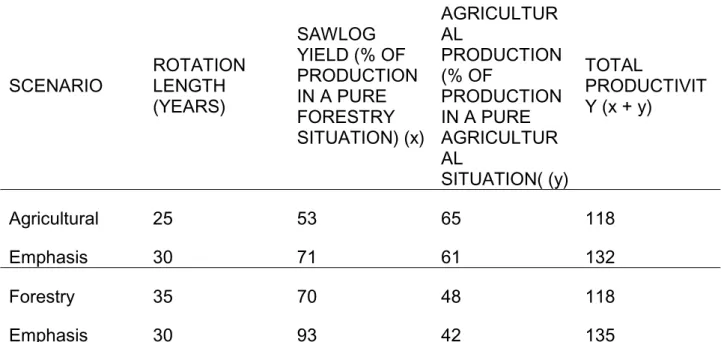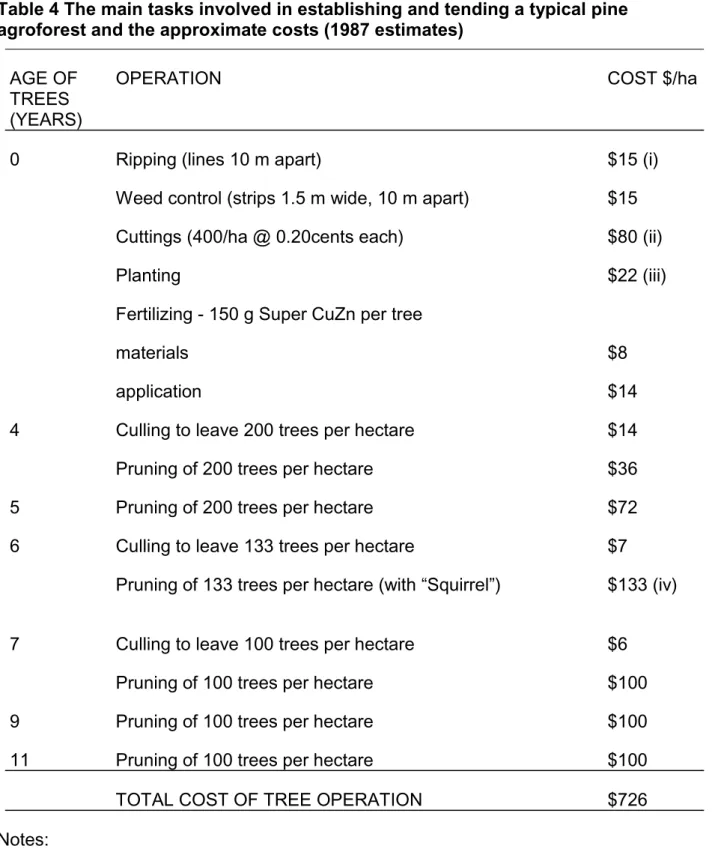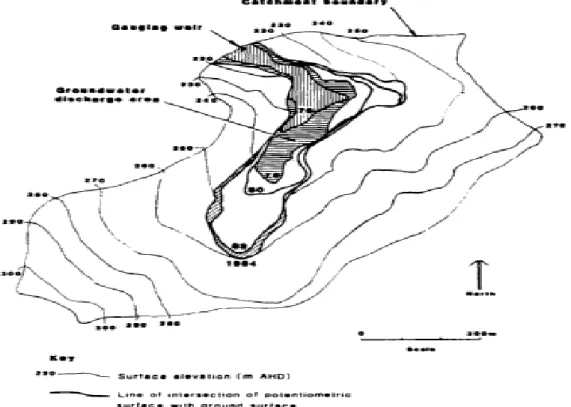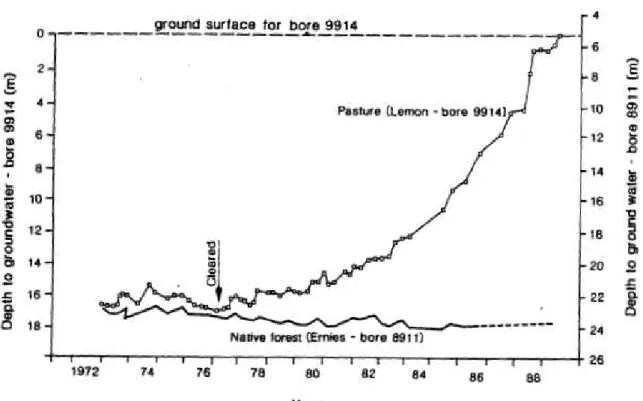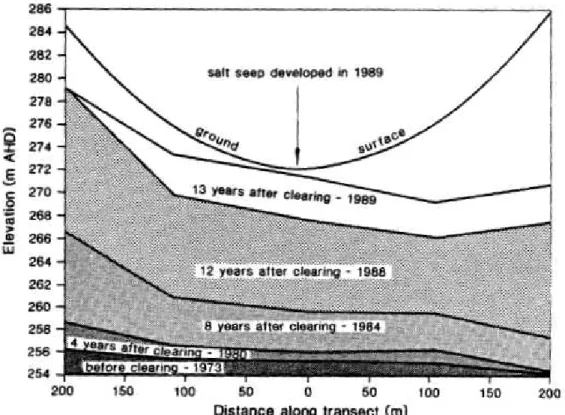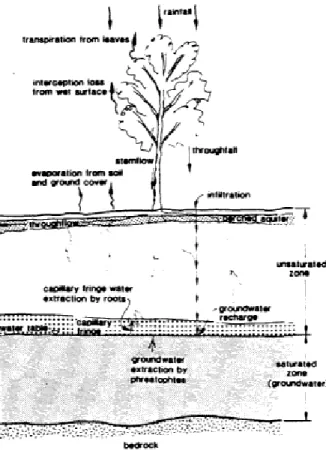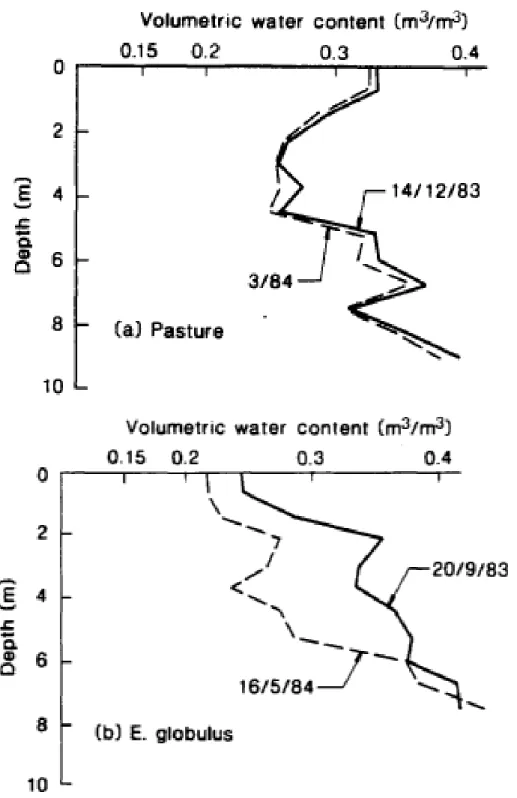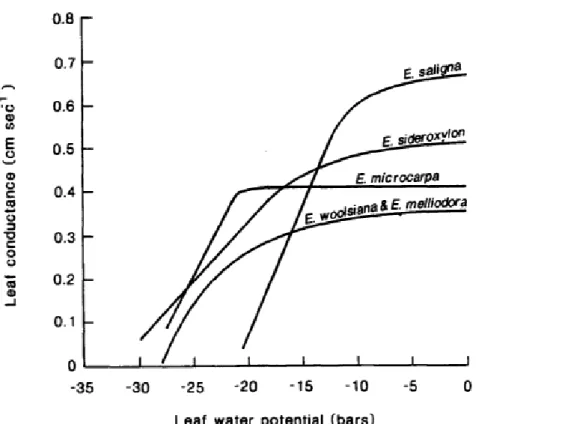The combination of trees and grasslands lowers groundwater levels (Schofield et al. 1989) and can reduce waterlogging. Due to the nature of agroforestry, compared to plantation forestry, it is considered important for the farmer to be a manager of both the trees and the agricultural component.
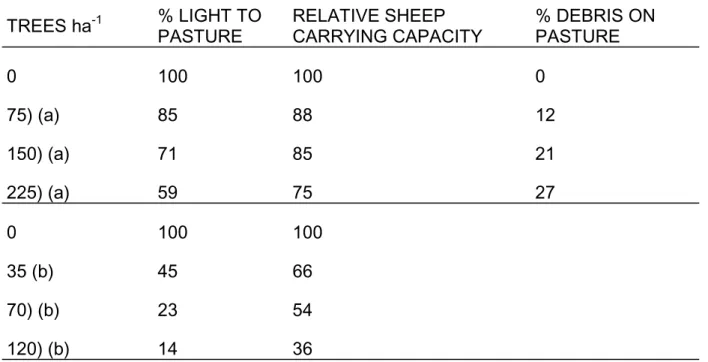
Effects of Trees on Saline Groundwater Tables
In the case of the Wights catchment (rainfall 1200 mm/yr), groundwater levels rose quickly after scouring (Figure 1) and the initial small discharge area (infiltration zone) expanded rapidly (Figure 2). Some of the common questions asked about tree planting are discussed in the next section in relation to the environment of south-west Australia.
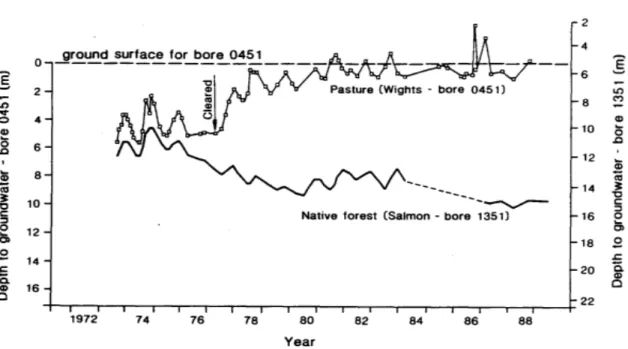
Reforestation to Control Groundwater - Some Common Questions
The strategies tested were (a) planting on lower slopes and drainage zones, (b) extensive plantations, (c) strips or small blocks strategically placed occupying only a small portion of the cleared area, and (d) dense plantations covering a large part (, 50%) of the cleared area. In the period 1979-88 there was a reduction of 2.0 meters in the groundwater level under reforestation, while under grassland the groundwater level rose by 0.4 meters (Figure 11). At each location, agroforestry has significantly lowered the water table relative to grassland and soil surface.
However, at Flynn's and Stene's sites, the lowering of the water table relative to pastures has stopped, suggesting that a new recharge-discharge equilibrium may have been reached. In the period 1979-88, there was a lowering of the groundwater table during replanting by 5.6 metres, while the water table during grazing rose by 0.4 meters (Figure 11). Plantings with a lower slope/discharge zone lowered the water table by 2.4 compared to pasture at the one site studied.
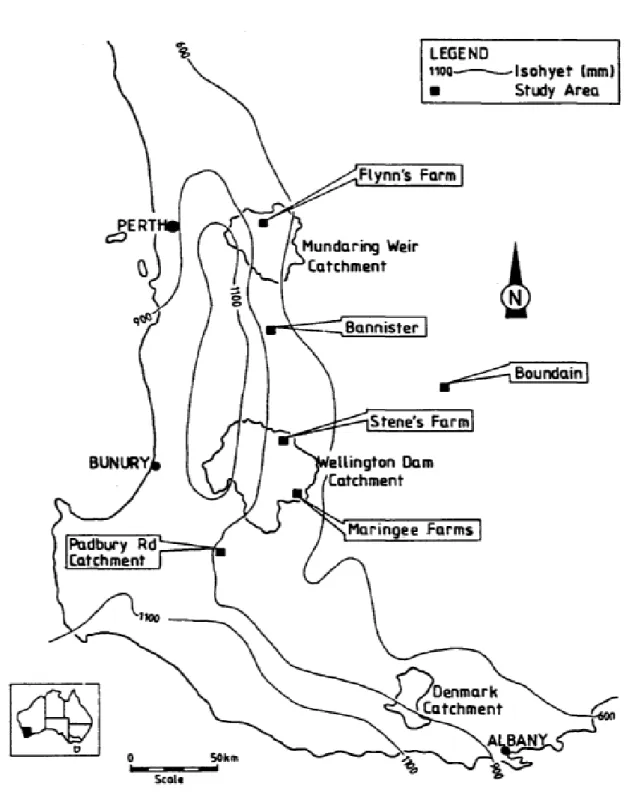
Acknowledgements
Windbreaks and Shelterbelts on Farms
Increased water use
Tree and shrub products
Wind speed is reduced by the height, spacing, orientation, density and shape of the windbreak. A sensible planting decision requires awareness of wind exposure losses and low water use, as well as the advantages of tree and shrub products in agriculture. Only in the lower southwestern and partly southern coast are wood products in themselves eligible for planting windbreaks.
Wind speed, direction and duration for times of the year - which are most damaging. Landforms and land use will help determine windbreak design, species composition and location. When designing windbreaks and shelterbelts for particular locations, it is important to consider a number of factors that will affect the value and success of the planting.
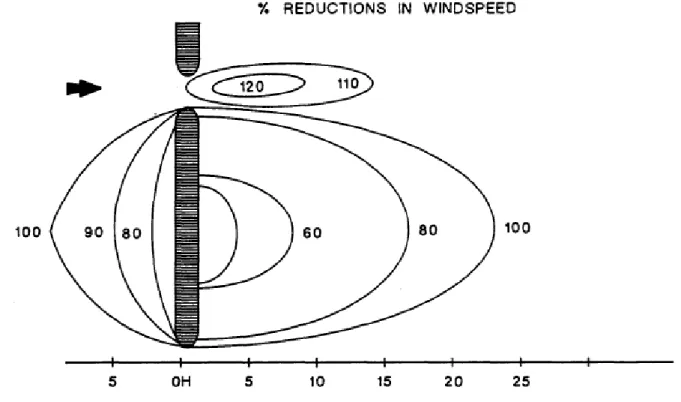
Evolution of the Forestry Sharefarming Concept
This realization coincided with the emergence of interest in softwood sharecropping in the Albany region. Perhaps the most important achievement to date in the development of the pulpwood cultivation industry has been the recognition of the potential for tree crops to be integrated with conventional farming practices. This is sufficient over the two million ha of agricultural land with rainfall greater than 600 mm in the lower south-west, to provide a land base for a large pulpwood growing industry.
In the case of salinity, this is due to the shallow, local scale character of the groundwater systems and the large quantities of salt that are leached from any area (up to five tonnes per ha per year). In the development of the pulpwood cultivation industry, prominence must be given to the following objectives. There is considerable scope to expand these types of studies to facilitate the rapid evolution of pulpwood agroforestry as a component of sustainable agriculture in the lower south-west of Western Australia.
Advances in Research on Tagasaste, Martindale Research Project, October 1988
Livestock production in south-western Australia is limited by the low feeding value of the dry annual pasture over the summer. The majority of research and development is carried out at Martindale Pty Ltd's properties in New Norcia, approximately 130 km north of Perth. Dunmar" was purchased to test the general hypothesis that dilapidated sand flat farms could be economically rebuilt by applying research findings from "Newdale".
Analysis of the edible leaves and stems of tagasaste in summer and autumn has shown crude protein levels around 15%. The plantation at "Newdale" is now 6 years old and is expected to have a life of at least 15 years. When discussing the tagasaste research at "Newdale", it is important to first understand the system of animal production in the absence of tagasaste before describing the new systems that incorporate tagasaste.
Traditional Pattern of Feed Supply and Wool Production
By the end of summer, the quantity and quality of dry grassland has normally deteriorated to the point where sheep lose live weight and body condition and ewes and weaners have to be hand-fed. Wool production is low at this time of the year, for a weaner about 7 grams of oily wool per day, feeding the grain is only to keep the sheep alive and prevent breakage in the wool. With about 16,000 ewes and weaners to be fed in "Newdale," the fall feed bill for sheep is about $58,000.
In most years, the amount of grassland is limited, but the amount of feed is compensated by the high quality of the feed. Due to the high quality of the pasture, the rate of wool growth increases to about 17 g per weaner per day. With longer days and higher temperatures, grassland production soon exceeds demand, so that in October 1987, "Newdale" offered 3 tons of dry matter.
Traditional Production from Deep Sands
March, April and May (autumn food gap. 92 days) The rains that open in April destroy the remaining dry food. Sands are best grazed in late fall, just after the season break when they show preference for early new season pasture production, and again lightly in spring/early summer.
Research into Establishing Tagasaste The 1st year
Fertilizer Placement: Experiments at "Newdale" showed a clear penalty for placing fertilizer too close to the seedbed of tagasaste. At “Dunmar” 25 kg of super-copper-zinc-molybdenum per km of row (50 kg/ha) was placed in the crack line 25 cm below the seedbed during deep drawing. This was followed by another press wheel and a loop of light chain to loosen some sand on the surface of the seed bed.
At "Newdale" an experiment showed a 300% increase in trees per ha after 12 months, when a tractor was driven into the seedbed after sowing (3000 verses 1000 trees per ha 12 months after sowing). At "Dunmar", a monitoring site was established (5 m of the row, within which the number and position of seedlings are recorded) in every 20 ha of tagasaste. At "Dunmar" an estimated 22 miles (35 km) of fencing was required, costing $800 per square foot. km to fence the tagasasten in the first year.
Research into the Management of Tagasaste The 2nd year
At 'Newdale', 900 mature tagasata trees per ha produced 7.5 tonnes of edible green matter per ha per year. This result and the lack of yield response to added fertilizer at 'Newdale' is likely due to past fertilizer applications. This may not be the case with 'Durimar', leaf analyzes will be used early in the second year to determine the rate to use.
At "Newdale" the trees were regularly cut to about half a meter in the second year. Fertilizer: As previously mentioned, 'Newdale' did not respond to added fertilizer, but this may not be true of 'Dunmar', which has a poor fertilizer history. Experience at Newdale has shown that sheep and cattle will not strip bark from uncut or freshly felled trees.
Research into New Farm Systems Using Tagasaste
In all experiments, sheep grazing tagasaste grew wool at a faster rate than flockmates grazing dry pasture or hand-fed. Assuming that the economic optimum stock for wool production is less than that for survival feeding of weanling calves, it seems reasonable to assume that a system of controlled grazing, paddocks of taga ash grazed for say 3 weeks once a year, 2500 sheep should deliver. pasture days per ha. Assuming further that the period of dry fodder is 210 days, 12 months' growth of tagasaste should support 12 sheep per ha over the summer.
However, there is currently no explanation for the breakdown of the relationship between pure fleece weight and average fiber diameter in wool grown from Tagasaste grazing sheep. In both experiments at Newdale the value of the additional wool produced by young tagasaste grazing was $4.80 per head. The value for summer plus autumn grazing of tagasaste for wool production is sensitive to both the number of grazing days per ha tagasaste and changes in wool.
Is it Economic to Grow Tagasaste?
The balance continues to decline until a peak debt of $315 is recorded in year 3, just before the first significant income from grazing tagassta. Once the balance becomes positive, it grows steadily, reaching $1,600 at the end of the fifteenth year. The idle bank balance at the end of the first year is $116 per hectare.
The debt peak is still in its third year, but the debt peak is low. Further, the bank balance approach emphasizes the financial need to cover the maximum debt of $315 per ha in the third year. Land Value Increase Approach: As seen in the annuity approach, tagasaste increases the profitability of deep sand.
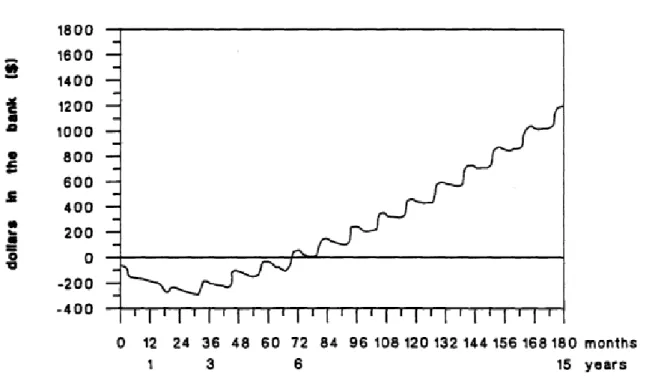
Increase in land values approach: As seen in the annuity approach tagasaste increases the profitability of deep sands. Land values reflect capitalization of the stream
In summary, the bank balance approach demonstrates the need for a farmer to have the finance available to sustain a high debt until at least the sixth year. An annuity is calculated at an interest rate, in this case a range of rates is given. In this case, an annuity is a hypothetical value that a farmer expects to receive each year.
He receives this return from an investor who commits the capital to settle the tagasaste on the farmer's deep sand in exchange for a fee when the farmer grazes the plantation. This annuity of $58 per ha is directly comparable to the expected return of $10 per ha from conventional deep sand farming. Annuity at a range of interest rates for tagasaste on deep barren sands, using "Dunmar" charges and expected returns.
Minimum return: In the analysis so far, the result of grazing trials at “Newdale”
Vegetation Farm Planning
Dryland salinity
The effects of switching to crops or perennial pastures on groundwater levels have not yet been documented. Strategic tree planting can be effective in lowering groundwater levels, but as Schofield has pointed out (this section), the area to be reforested and its positioning will be critical to its success. Salt-tolerant clones of Eucalyptus camaldulensis are about to be tested for their ability to lower saline groundwater levels and produce wood for pulp production in the high-rainfall southwest region.
Well-spaced plantings have been shown to lower water tables and provide many other benefits (G. Anderson and R. Moore, this volume). Dense, extensive plantation forests are most effective at lowering groundwater levels and can provide shelter and other benefits. It should be remembered that more than 15% of the deforested area needs to be reforested to have a significant impact on groundwater in an area with a rainfall exceeding 700 mm (N. Schofield, this volume).
Wind erosion
Providing extra feed during the summer/autumn drought and reducing soil erosion of bare salinized areas are major advantages. Trees can also be used on saline areas in wide spaced and dense configurations and have lowered water table.
Water erosion
Dam pollution
These areas can be used as tree plantations as long as the density is low enough to allow good grass growth.
Dam evaporation
Stock shelter
Aesthetics
Conservation
Remnant vegetation protection
Infertile soils
Trees for drainage
